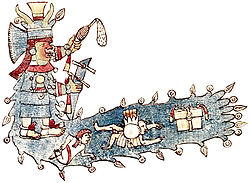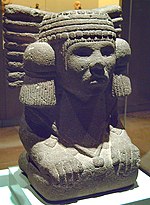Chalchiuhtlicue
Chalchiuhtlicue (also Chalciuhtlicue, Chalcihuitlicue or Acuecucyoticihuati ) was the goddess of stagnant waters and rivers in Aztec mythology . Chalchiuhtlicue means in Nahuatl the one with the jade skirt .
Appearance
Chalchiuhtlicue was considered a young, beautifully dressed girl. Pictures of her are known from numerous Mexican manuscripts: the Codex Borgia (plates 11 and 650), the Codex Borbonicus (page 5), the Codex Rios (page 17) (belongs to the Codex Telleriano-Remensis ) and the Codex Florentinus (plate 11 ). According to its name, it was usually carved as a sculpture in greenish stone. A sculpture shows her kneeling with a youthful face, which is emphasized by side braids. Amaranth seeds on the headgear indicate their divine position. In pictorial representations, she wears a green or blue skirt, as well as necklaces and earrings with precious stones. Sometimes water pours out of her skirts, in which newborn babies can be seen, or she is symbolized by a river, on the bank of which an opuntia is growing, covered with prickly pears .
Assignments
Chalchiuhtlicue was considered the wife of the rain god Tlaloc . With him she ruled Tlalocan , the paradise of the middle level of the Aztec afterlife, open to all drowned people and those who had died of something to do with water. Abundance and joy reigned in Tlalocan. With Tlaloc Chalchiuhtlicue had Tecciztecatl testified that according to the Aztec creation myth ( Leyenda de los soles ) in the creation of the Fifth Sun because of his fear of fire Nanahuatzin subject. Before the Fifth Sun was created by Nanahuatzin's prowess, Chalchiuhtlicue ruled the Age of the Fourth Sun , which set in a flood, turning people into fish. While the waters of Tlaloc were considered beneficial in principle, Chalchiuhtlicue stood more for its ambiguous aspects. So it is said by Bernardino de Sahagun :
- The one with the green gemstone hip scarf, that's the water. It was regarded as a deity and attributed to the rain gods .... She was feared ... because she flooded with water ... killed in water .... She causes water to foam ... it pulls people into the abyss. ..The ships capsize ... Water floods people ... drowns them ... thunders, crackles, is excited in the storm .
In addition to her job as the goddess of water, Chalchiuhtlicue was also responsible for births and women in childbed. Therefore, at the Aztec baptism, the priests ritually turned to the goddess:
- Madam Chalchiuhtlicue, your servant present here has come into this world, sent from our father and mother, from Ometecutli and Omeciuatl ... We do not know what was assigned to him before the beginning of the world ... whether this fate is good or bad is ... look at him between your hands ... free him from uncleanness, for he is subject to your power ... may this water remove all evils ... to wash from him evil ... dignity to do, what we ask where now this child is with you .
Aztec mythology sometimes equated Chalchiuhtlicue with the Tlaxcaltek rain goddess Matlalcueitl .
In the Aztec calendar , Chalchiuhtlicue was assigned the Trecena from the 1st reed to the 13th serpent, followed by the Trecena Tonatiuhs . In front of it was the Trecena Huehuecoyotls . In the Tonalamatl of the Codex Borbonicus Chalchiuhtlicue is assumed to be the first month, the fifth week, the fifth day, the third hour of the day and the sixth hour of the night.
literature
- Heike Owusu: Symbols of the Inca, Maya and Aztecs , Schirner Verlag Darmstadt (2000), ISBN 3-89767-073-9
- Günter Lanczkowski, The Religion of the Aztecs, Maya and Inka , Wissenschaftliche Buchgesellschaft Darmstadt (1989), ISBN 3-534-03222-5
- Karl Taube : Aztec and Maya myths , Phillip Reclam jun. Stuttgart (1994), ISBN 3-15-010427-0
- George C. Vaillant: The Aztecs , M. Dumont Schaumberg Verlag, Cologne (1957)
- Eduard Seler: Some chapters from the historical work of Fray Bernardino de Sahagun , Stuttgart (1927)
- Jacques Soustelle: How the Aztecs Lived on the Eve of the Spanish Conquest , Deutsche Verlagsanstalt Stuttgart (1956)
Web links
supporting documents
- ↑ George C. Vaillant: The Aztecs , page 178
- ↑ Heike Owusu: Symbols of the Inca, Maya and Aztecs , page 179
- ^ Karl Taube: Aztec and Maya myths, page 60
- ^ Eduard Seler: Some chapters from the historical work of Fray Bernardino de Sahagun , quoted from Günter Lanczkowski, page 46
- ^ Fray Bernardino de Sahagun: Historia de las cosas de Nueva Espana , quoted from Günter Lanczkowski, page 56
- ↑ George C. Vaillant: The Aztecs, pages 184

